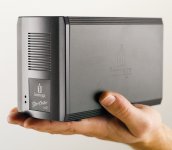This resource was originally created by user: jgreco on the TrueNAS Community Forums Archive. Please DM this account or comment in this thread to claim it.
The NAS marketplace is filled with small appliance NAS devices, often built on an ARM device platform. These small devices, such as 2009’s iomega StorCenter IX2-dl (2x 3.5" HDD) and 2019’s Synology DS419slim (4x 2.5" HDD) are handfuls of modest network storage joy.
My companies own and use a number of these devices. They’re small and practical for certain use cases.
We’ve had numerous discussions over the years in the FreeNAS forums about why this seems difficult to duplicate with FreeNAS, and in one thread, I went to a little extra effort to talk about it, which @Ericloewe ended up trashing for unrelated reasons. We agreed that this is nevertheless an interesting topic, and I wanted to not-lose this information. I don’t know exactly what is going to happen with this. I am kinda hoping people discuss the ins and outs of any solutions they find.
The fundamental problem is that you’re going to find it extremely difficult to build a competent small form factor system out of generic parts.
Companies like HP put significant effort and customization into designing things like the HPE ProLiant MicroServer Gen10 Plus, which at 10"x10"x5" is about 500 cubic inches.
Compare that to your Bitfenix Phenom M at 13"x15"x10" or about 1950 cubic inches, nearly 4x as large.
Or the Supermicro SYS-5029S-TN2, the SC721 chassis, similar to the FreeNAS Mini, at 10"x8"x11", or 880 cubic inches, which is one of the most compact things you can easily get made out of at least somewhat generic standards-compliant parts.
The reason that the HP MicroServer is 500 cubic inches is because they started out from the beginning with a blank slate and no requirement that they conform to any standards. Ditching standards and just doing their own thing is how they make those tiny EliteDesk thingys too.
Trying to compete with this with a homebuilt is difficult. You have obvious issues and problems with things such as excess cable slack, and most people building a NAS do not have the supplies on hand to do stuff like customizing the length of PSU cabling to get rid of excess cable. This does indeed, as you note, make cable management very difficult.
Just look at how compact that HP box is. There’s nothing there but drives, board, and fans… the astute reader will note that they’ve cheated by externalizing the PSU. [image]
Now just to be clear, I’m not trying to rain on anyone’s parade here. I’m actually circling around to make a point. And the point is that you probably shouldn’t obsess too much over space efficiency. It’s really hard to do well, and the big PC standard components do not work out too well in any of these.
Previous threads such as this one:
Finding the dream small footprint NAS chassis.
hello everyone, I think this is a recurrent question but I can’t find the right solution for what I need. First I use this chassis at the moment (CFI-A7879): It is not a really a good one but at the time I build my NAS it was the only one I’ve found for my small appartment (1 room). (btw this…
haven’t come to any particularly happy conclusion. There are a few suggestions in the hardware guides such as over at
Hardware Recommendations Guide
This is the latest edition of the FreeNAS Community hardware recommendations guide. The current major version is R2, dated January 2021, with the last minor update on 2021-01-24. The format has moved away from the forum post form factor, to…
But in general, small footprint systems are hard to come by. I am happy to spotlight any good solutions that come along. We’ve had a number of bad solutions appear over the years, usually with cooling-related problems.



